Sewer cleaning cable: types of tools and how to use them correctly
A blockage in the sewer pipe is a nuisance that can happen unexpectedly. Draining in an apartment or cottage can clog at any time. And it’s not always possible to clean it with household chemicals or a plunger.
Agree, calling plumbers expensive and long. It's easier to take a cable to clean the sewer and get rid of the problem yourself manually. This tool is simple to use and does not require specialized skills from a home master.
We will tell you how to choose the right simple device, what rules should be followed when cleaning the sewer. And also give an example of self-manufacturing a simple cable.
The content of the article:
What is a plumbing cable and why is it needed?
Technicalchemistry-based productsand ways for cleaning sewer pipes there are many. But the plumbing cable (aka flexible shaft) among them is the simplest, cheapest and most effective option.
With its help in the pipeline it is possible to destroy even old traffic jams from garbage or mud deposits. With this hand tool, risers, drains, toilets and other plumbing are easily cleaned.
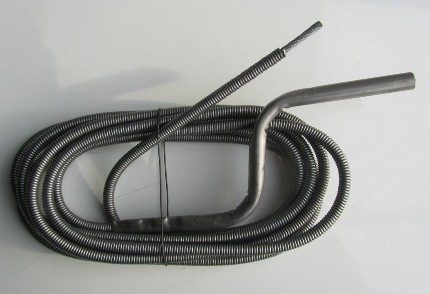
Now everywhere, cast-iron sewer pipes in apartments are being replaced by analogs of plastic. Thanks to the smooth walls inside, plastic drains are less likely to clog than old pipelines made of cast iron. But even in them, blockages still form.
Rags and plastic bags thrown into the toilet bowl turn into tubes in a pipe, which can only be destroyed mechanically.
How to choose the right option
Principle use of plumbing cable extremely simple. First, the tool is pushed into the sewer pipe until it stops, so that it ends against a blockage.
Then, by means of rotational and reciprocating movements, the handle of the tool picks up the cork with the tip of this end to pull it out or destroy it in place inside the pipeline.

The specifics of the application and the efficiency of use depends on the cable device, the correct choice of tool size.
Consideration of design features of different models
There are four types of plumbing cables in hardware stores:
- cable cars - classic thin rope (rod) of several wires;
- spring - hollow spring, twisted from a wire;
- spring-wound - a flexible core with a spiral wound from the outside;
- tape (flat) - tape 1–4 cm wide.
Everyone has varieties of plumbing cable work items (handles, nozzles, tapes, wires) are usually made of durable steel.
There are models in which the spiral is externally covered with a rubberized shell that protects the inner walls of the pipes from mechanical damage by metal. But in most cases, a plumbing cable is just a steel spring without any braid.
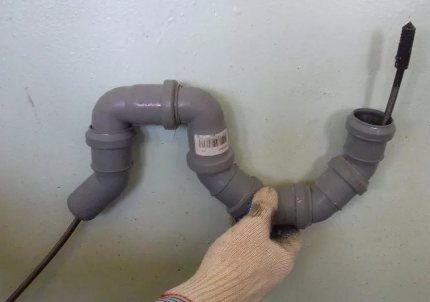
Cable. A small cable rope 1.5–3 meters long belongs to the household category of tools. It is ideal for sink cleaning, eliminate blockage in the toilet and on horizontal sections of pipelines to a common riser.
Trying to "break" the cork in the depths of the sewer is meaningless. Such a plumbing cable will either not reach the blockage, or it will not simply be able to destroy it.
Spring loaded. The cable is small and ideal for cleaning in-house risers and suitable plumbing fixtures sewer pipes.
Core cable. This is a professional tool that can be used to push the weed plug.It is difficult to do something like this with an ordinary spiral because of its greater softness and compressibility.
Tape. Such a tool is not flexible enough and is not able to go to all corners of the sewer. It, unlike a spring, bends only in one plane. But the ribbon cable has smaller dimensions in a twisted state.
Most often it is used to clean long trunk pipes of large diameter, which have an order of magnitude less bends than in house buildings.
Determination of the optimum working diameter
When buying a cable for cleaning sewer pipes, you must correctly select its cross section. Too thick a tool to clean the sink or urinal is unlikely to succeed. He simply will not enter the drain hole. Such a flexible shaft is designed for cleaning risers and wide pipes of large diameter.

Corresponding diameters of pipes and plumbing:
- pipe D <50 mm - the flexible shaft should be selected with a cross section of up to 10 mm;
- pipelines in 50-110 mm - you need a cable with a diameter of 11-15 mm;
- vertical risers more than 100 mm - you need to choose a tool with a thickness of 16 mm.
An excessively thin 3-4 mm cable can break when the cork is pulled out of the pipe. Such a device is more suitable for cleaning siphons and removing plums from hair.
Punching them with a thick pipe with a blockage in the form of a rag is not worth it. A more solid option is required here.
Comparison of a hand tool with an electric
A cable for cleaning sewer pipes has a lot of advantages:
- high torque;
- ideal balance of elasticity and flexibility;
- safety of use;
- simplicity and ease of use;
- high cleaning efficiency;
- the possibility of using different purpose nozzles.
With active use for the intended purpose, the spiral of the cable loses its elasticity over time (breaks loose) and simply breaks. But with proper care, cleaning and oiling after work, this device will last more than one year.
All plumbing cable is good. It is easy to use and cheap. However, this is still a manual tool for which a person needs to make certain efforts. But you can modify it a bit or purchase a professional electrical appliance.

Professional plumbers prefer to use special tools to facilitate work. It can be either a handle on a rigid and stable stand, or a full-fledged power tool with a motor. Plus there are various nozzles for different types of blockages.
A manual version of a conventional plumbing cable is cheaper and smaller in size than an electric counterpart. However, the latter greatly simplifies the cleaning of sewer pipes. If the tool is needed for one-time work, then there is no reason to spend much on it.
However, if you have to clean the sewers constantly on a professional basis as a plumber, then you should seriously think about purchasing a power tool.
Types of nozzles used
Typically, a plumbing cable for sewage has a hook at the working end to pry off a garbage stopper in the pipe. But a professional tool is instead equipped with a threaded connection for winding a wide variety of nozzles. They can be included with the flexible shaft or sold separately from it.
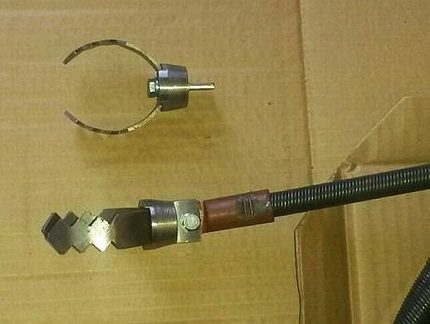
As a replacement nozzle, the end of a flexible plumbing shaft can be worn:
- «screw"- to remove non-solid deposits from the walls of pipes;
- «hook"- for winding and picking up soft knitwear, etc. of things;
- «scraper"- for use in wide pipes and disposal of sediment from fats;
- «harpoon"- for the possibility of impact on the cork with the aim of its engagement and pulling;
- «sliding knife"- for more thorough cleaning of the pipe walls;
- «pick"- for breaking down fatty growths.
There are also spiral, serrated and other knives. Each of them is designed for its own kind of blockage. They can even remove roots and dense calcareous deposits from piping systems.
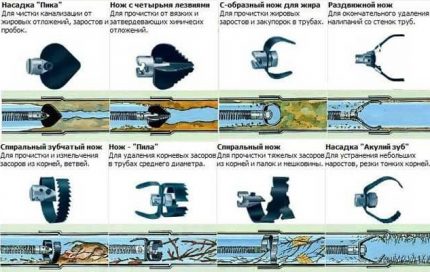
To enhance the capabilities of a conventional flexible shaft without nozzles and connectors for them, experienced plumbers recommend fluffing the end of the cable.
Rigid wires sticking out in different directions while in the pipe will more reliably catch rags and other debris. This will simplify and speed up cleaning. But such an upgrade can only be used in metal pipelines. Plastic walls will quickly be damaged by hard hooks.
The nuances of cleaning pipes with a cable
Before cleaning the sewer with a metal cable, the nature of the blockage and the degree of clogging should be assessed. If it is just a rag or a lump of thick cardboard, then a flexible plumbing shaft is an ideal tool for such a cleaning.
However, if a technological blockage has formed in the pipe, which is directly related to the wear of the pipes and their narrowing due to rust, then only a complete relocation of the sewer system will help here.
The handle of the plumbing cable should be turned exclusively clockwise when it is inserted into the sewer. So the spiral, when resting on the garbage plug, will begin to gradually contract, increasing pressure and torque.
If the blockage is complex and large, then the process of pushing the cable with the meshing of the cork and pulling out the garbage will have to be done several times.

If the sewer pipelines are made of plastic, then the cable is best taken with a rubberized braid for cleaning. It will less scrape the plastic walls of the pipes, inevitably damaging them. So the sewer will last much longer.
Before starting work, the spiral should be carefully inspected for possible damage. If it breaks inside the pipeline during cleaning, it will be problematic to get it. To pull out a scrap later, you need to disassemble the sewer.
When a cable is jammed in a pipe, it must be carefully and leisurely started to rotate in different directions to release it. You can not pull the tool. And in general, when working, do not put too much effort.
After breaking the plug in the pipe with a cable, the sewer should then be washed additionally with boiling water. It does not hurt to pour in the drain and a solution of vinegar with baking soda or another version of the fat-dissolving chemistry. Prevention here will not hurt, but only contribute to the stable operation of the sewage system.
After each use, the flexible shaft must be cleaned of adhering dirt. In addition to hot water, it is necessary to use cleaning and fat-breaking agents. For storage, the cable is folded up after wiping with a dry cloth. It is made of galvanized steel, but to leave a drop of water on it is still not worth it.
Subtleties of manufacturing a similar tool
Instead of a factory product, you can also use a homemade plumbing cable to clean the sewer. It is quite possible to make it from improvised materials.
The simplest analogue is a piece of flexible wire with a bent end. However, such a device can only clean a shallow blockage.Thick wire is not flexible enough to push it too far into a curved pipe.
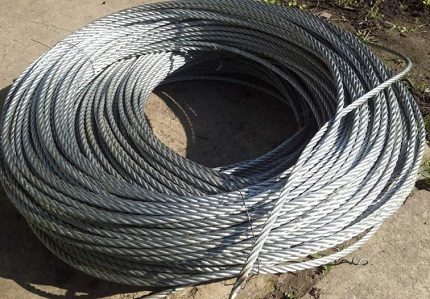
The procedure for manufacturing a hand tool for mechanical cleaning of sewers:
- Cut a piece of 1-3 meters long from a metal cable.
- Fluff one end to form a brush.
- Twist the other end into a ring and attach a handle to it for convenience.
- Treat steel with an anti-corrosion compound.
A plumbing cable made in this way can be used for cleaning toilets, bathtubs and sewer pipes.
It is not as versatile as a professional cleaning device, but it is quite suitable for independent use in everyday life.
Conclusions and useful video on the topic
Several interesting videos will help you in choosing a tool and tell you how to make a cable with your own hands.
The device for cleaning the sewage system without chemicals:
How can I modify the cable for cleaning pipes:
A detailed briefing will help to make a homemade cable:
The mechanical method of cleaning the sewage system is used only as a last resort, when household chemicals and plungers are no longer able to help.
Working with a plumbing cable is not the most pleasant pastime. Specific sewage mud is poorly washed and extremely aggressive. But with a serious blockage, this flexible shaft is indispensable. And you don’t even need to call the plumbers, you can clean the clogged pipe yourself.
Have experience in dealing with sewage blockage? Please share information with our readers, suggest your own way to solve the problem. You can leave comments in the form below.

 Sewerage flushing: pipe cleaning methods + main causes of blockages
Sewerage flushing: pipe cleaning methods + main causes of blockages  The smell from the sewer in the apartment: types of technical malfunctions and methods for their elimination
The smell from the sewer in the apartment: types of technical malfunctions and methods for their elimination 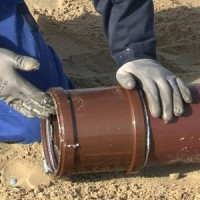 PVC pipes for outdoor sewage: types, sizes, advantages and disadvantages
PVC pipes for outdoor sewage: types, sizes, advantages and disadvantages  Cast iron pipes for outdoor sewage: types, features of application and installation
Cast iron pipes for outdoor sewage: types, features of application and installation  Corrugated pipes for external sewage: types, rules and standards of application
Corrugated pipes for external sewage: types, rules and standards of application  Sewer pipes for outdoor sewers: types and overview of the best brands
Sewer pipes for outdoor sewers: types and overview of the best brands  How much does it cost to connect gas to a private house: the price of organizing gas supply
How much does it cost to connect gas to a private house: the price of organizing gas supply  The best washing machines with dryer: model rating and customer tips
The best washing machines with dryer: model rating and customer tips  What is the color temperature of light and the nuances of choosing the temperature of the lamps to suit your needs
What is the color temperature of light and the nuances of choosing the temperature of the lamps to suit your needs  Replacement of a geyser in an apartment: replacement paperwork + basic norms and requirements
Replacement of a geyser in an apartment: replacement paperwork + basic norms and requirements
A cable refers to things that everyone must have at home. It’s not even that it’s expensive to call craftsmen, you can solve this problem yourself much faster. I do not advise doing the cable myself, because there may be a situation in which the sewer will have to be cleaned of additional litter. For apartment communications, a five-meter option is quite enough. All these electrical devices have not yet been properly brought to the optimum state, therefore, manually more efficiently. It is important not only to push, but also to rotate as you type.
From the experience of cleaning clogged pipes, I know that the cable is the most reliable tool. I use it, as shown in the first photo. The cable should be of sufficient thickness so that it is convenient to twist and move forward. Thin - just breaks out of hands.
The most detailed, of course, post about cables: for the first time I learned that there are cable attachments (although how to pull out with such a nozzle, if it clings to what?) And what can be turned with a drill (or a screwdriver) - also a controversial option (to fix-detach). And, of course, a little off topic, but the best chemical means for clearing blockages is a gel mole. I tried everything else, it helps not very much.
“Mole” Gel tried - helps in some cases. But not always. The most reliable is still an ordinary cable. Here he can handle any pipe.
Nothing helps.Either my cable cannot go through the turn or the iron can already begin to pour in. In short, I hit.
Not necessarily hit, you can still try to get by with "little blood." Invite the plumber, there is such a method of breaking through the sewage system as a pneumohydroimpulse or the use of a pneumatic gun. If it is still a congestion, and not a crumbling pipe, the costs will be much lower than on mechanical diagnostics of the system.